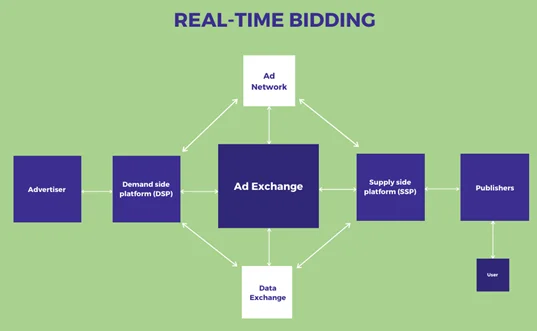In the evolving digital advertising landscape, real-time bidding (RTB) has become a cornerstone technology that automates and optimizes the process of buying and selling ad inventory. By transforming traditional ad transactions into dynamic, data-driven auctions, RTB enhances efficiency, precision, and scalability. This article explores how RTB achieves these efficiencies, detailing its operational mechanics, strategic benefits, and challenges that advertisers must navigate to maximize its potential.
The Mechanics of RTB
RTB functions as an automated auction where advertisers bid for individual ad impressions in real time. The process unfolds in milliseconds:
- Ad Request: A user visits a webpage or app with available ad space, triggering an ad request.
- Data Collection: The system gathers information about the user, including browsing behavior, device type, and location.
- Auction Commencement: This data is sent to an ad exchange, where an auction begins for the impression.
- Bidding Process: Advertisers, through demand-side platforms (DSPs), evaluate the impression and place real-time bids.
- Winning Bid Selection: The highest bidder wins, and their ad is instantly served before the page fully loads.
- Ad Display: The winning ad appears on the screen, completing the process.
By allowing advertisers to purchase ad impressions individually rather than in bulk, RTB eliminates inefficiencies associated with traditional ad buying models.
Efficiencies Gained Through RTB
1. Precision Targeting
RTB uses extensive data analytics to ensure ads reach the most relevant audience, reducing wasted impressions and increasing engagement. Advertisers can target users based on:
- Demographics (age, gender, income).
- Behavioral data (past browsing habits, purchase history).
- Contextual relevance (content of the webpage being viewed).
2. Cost Efficiency
RTB allows advertisers to:
- Set maximum bid prices for impressions, ensuring they only pay for ads that meet their targeting criteria.
- Avoid overpaying for low-value ad placements that may not convert.
- Optimize budget allocation by prioritizing high-performing impressions.
3. Real-Time Optimization
RTB provides instant performance feedback, enabling advertisers to:
- Adjust bidding strategies based on real-time data.
- Modify targeting parameters to improve conversion rates.
- Optimize ad creatives dynamically using Dynamic Creative Optimization (DCO).
4. Scalability
RTB allows advertisers to expand their campaigns across a vast network of publishers without requiring direct negotiations. This automation enables brands to reach global audiences efficiently while maintaining targeting accuracy.
Strategic Considerations in RTB
1. Understanding User Data
RTB relies on high-quality data for effective targeting. Advertisers should:
- Use first-party data for more accurate audience segmentation.
- Work with Data Management Platforms (DMPs) to refine targeting strategies.
- Adapt to privacy regulations that restrict third-party data usage.
2. Bid Strategy Optimization
Winning an RTB auction requires more than just bidding high—it requires bidding smart. Advertisers should:
- Analyze historical performance data to determine optimal bid amounts.
- Implement AI-driven bid automation to adjust bids dynamically.
- Focus on high-value impressions rather than maximizing reach.
3. Creative Alignment
Even with precise targeting, an ad must capture attention to be effective. Advertisers can enhance ad engagement by:
- Using DCO to tailor ad messaging and visuals in real time.
- A/B testing different ad variations to identify high-performing creatives.
- Ensuring ads are aligned with the user’s interests and intent.
4. Managing Latency
RTB auctions happen in milliseconds, and delays in processing bids can lead to missed opportunities or increased costs. Advertisers should:
- Work with high-speed DSPs that can process bid requests efficiently.
- Optimize their ad server response times to prevent bidding delays.
Challenges and Considerations
1. Ad Fraud
Automated ad transactions are vulnerable to fraudulent activity, including:
- Bot traffic generating fake impressions.
- Domain spoofing, where fraudulent sites impersonate premium publishers.
- Click fraud, artificially inflating engagement metrics.
To prevent fraud, advertisers should:
- Use ad verification tools to filter out invalid traffic.
- Partner with reputable ad exchanges that enforce strict quality controls.
2. Privacy Compliance
With evolving data privacy laws like GDPR and CCPA, advertisers must:
- Ensure ethical data collection and compliance with user consent regulations.
- Shift towards privacy-first targeting methods such as contextual advertising.
3. Brand Safety
RTB can sometimes result in ads being displayed next to inappropriate or harmful content. To mitigate brand safety risks, advertisers should:
- Use whitelists and blacklists to control ad placements.
- Implement brand safety filters to prevent ads from appearing in undesirable environments.
The Future of RTB in Advertising
1. AI and Machine Learning
AI-powered RTB will:
- Predict user engagement likelihood before bidding.
- Automate bid adjustments to maximize efficiency.
- Enhance personalization by dynamically optimizing ad creatives.
2. Privacy-Focused RTB
As third-party cookies disappear, RTB will shift towards:
- First-party data strategies for more accurate audience targeting.
- Contextual targeting, where ads align with webpage content rather than user behavior tracking.
3. Blockchain for Transparency
Blockchain technology has the potential to:
- Track ad transactions, reducing fraud.
- Ensure fair pricing and payment distribution in the ad supply chain.
4. Programmatic Direct
A hybrid approach combining RTB automation with direct ad deals will allow advertisers to:
- Secure premium ad placements with guaranteed inventory.
- Gain greater control over ad placement and pricing.
Maximizing Efficiency with RTB
To fully leverage RTB, advertisers should:
- Invest in high-quality data to improve targeting accuracy.
- Stay adaptable, adjusting strategies based on real-time insights.
- Use AI-driven bidding to optimize costs and maximize performance.
- Ensure privacy compliance to build consumer trust.
- Prioritize brand safety to prevent negative ad placements.
Driving Advertising Forward with RTB
RTB has transformed digital advertising, enabling faster, more cost-effective, and highly targeted ad transactions. Advertisers who refine their RTB strategies will:
- Reach high-value audiences efficiently.
- Optimize ad spend for maximum ROI.
- Stay ahead of industry changes by adopting AI, automation, and privacy-first strategies.
As digital advertising continues to evolve, RTB will remain essential for brands seeking scalable, data-driven advertising solutions that drive engagement and business growth.

